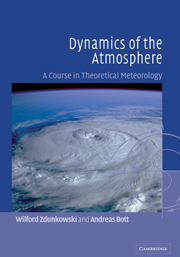Book contents
- Frontmatter
- Contents
- Preface
- Part 1 Mathematical tools
- Part 2 Dynamics of the atmosphere
- 1 The laws of atmospheric motion
- 2 Scale analysis
- 3 The material and the local description of flow
- 4 Atmospheric flow fields
- 5 The Navier–Stokes stress tensor
- 6 The Helmholtz theorem
- 7 Kinematics of two-dimensional flow
- 8 Natural coordinates
- 9 Boundary surfaces and boundary conditions
- 10 Circulation and vorticity theorems
- 11 Turbulent systems
- 12 An excursion into spectral turbulence theory
- 13 The atmospheric boundary layer
- 14 Wave motion in the atmosphere
- 15 The barotropic model
- 16 Rossby waves
- 17 Inertial and dynamic stability
- 18 The equation of motion in general coordinate systems
- 19 The geographical coordinate system
- 20 The stereographic coordinate system
- 21 Orography-following coordinate systems
- 22 The stereographic system with a generalized vertical coordinate
- 23 A quasi-geostrophic baroclinic model
- 24 A two-level prognostic model, baroclinic instability
- 25 An excursion concerning numerical procedures
- 26 Modeling of atmospheric flow by spectral techniques
- 27 Predictability
- Answers to Problems
- List of frequently used symbols
- References and bibliography
- Index
20 - The stereographic coordinate system
Published online by Cambridge University Press: 05 June 2012
- Frontmatter
- Contents
- Preface
- Part 1 Mathematical tools
- Part 2 Dynamics of the atmosphere
- 1 The laws of atmospheric motion
- 2 Scale analysis
- 3 The material and the local description of flow
- 4 Atmospheric flow fields
- 5 The Navier–Stokes stress tensor
- 6 The Helmholtz theorem
- 7 Kinematics of two-dimensional flow
- 8 Natural coordinates
- 9 Boundary surfaces and boundary conditions
- 10 Circulation and vorticity theorems
- 11 Turbulent systems
- 12 An excursion into spectral turbulence theory
- 13 The atmospheric boundary layer
- 14 Wave motion in the atmosphere
- 15 The barotropic model
- 16 Rossby waves
- 17 Inertial and dynamic stability
- 18 The equation of motion in general coordinate systems
- 19 The geographical coordinate system
- 20 The stereographic coordinate system
- 21 Orography-following coordinate systems
- 22 The stereographic system with a generalized vertical coordinate
- 23 A quasi-geostrophic baroclinic model
- 24 A two-level prognostic model, baroclinic instability
- 25 An excursion concerning numerical procedures
- 26 Modeling of atmospheric flow by spectral techniques
- 27 Predictability
- Answers to Problems
- List of frequently used symbols
- References and bibliography
- Index
Summary
For the analysis and depiction of meteorological data it is useful and customary to map the surface of the earth onto a plane. Therefore, it is advisable for purposes of numerical weather prediction to formulate and evaluate the atmospheric equations in stereographic coordinates. Such a map projection should represent the spherical surface as accurately as possible, but obviously some features will be lost. It is extremely important to preserve the angle between intersecting curves such as the right angle between latitude circles and meridians. Maps possessing this desirable and valuable property are called conformal. If distances were preserved by mapping the sphere onto the projection plane, the map would be called isometric. Mapping from the sphere to the stereographic plane is conformal but not isometric. In order to remove this deficiency to a tolerable level, a scale factor m, also called the image scale, will be introduced.
The stereographic projection
We will now describe the sphere-to-plane mapping by introducing a projection plane that is parallel to the equatorial plane. On the projection plane we may construct a Cartesian (x, y, z)-coordinate system with a square rectangular grid. The stereographic Cartesian coordinate system differs from the regular Cartesian coordinates since the metric fundamental quantities are not gij = δij. In fact, they still contain the Gaussian curvature 1/r of the spherical coordinate system, showing that in reality we have not left the sphere.
- Type
- Chapter
- Information
- Dynamics of the AtmosphereA Course in Theoretical Meteorology, pp. 542 - 564Publisher: Cambridge University PressPrint publication year: 2003



